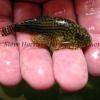Chinese hillstream loach - Pseudogastromyzon cheni
Scientific name: Pseudogastromyzon cheni
Common name: Chinese hillstream loach
Family: Balitoridae
Usual size in fish tanks: 6 - 7 cm (2.36 - 2.76 inch)
014
Recommended pH range for the species: 6.5 - 7.5
Recommended water hardness (dGH): 4 - 12°N (71.43 - 214.29ppm)
0°C 32°F30°C 86°F
Recommended temperature: 21 - 24 °C (69.8 - 75.2°F)
The way how these fish reproduce: Spawning
Where the species comes from: East Asia
Temperament to its own species: peaceful
Temperament toward other fish species: peaceful
Usual place in the tank: Bottom levels
Origin
The Chinese hillstream loach can be found in many Asian waterways but is primarily found around China and Hong Kong. It inhabits fast moving waters that are well oxygenated.
Short description
These fish are a great addition to the aquarium but they do require pristine water conditions and should never be added to an immature set up. They have developed their mouths to form a sucker which allows them to grasp onto rocks etc. in the waterways. The have also developed a slightly flattened head shape to make them more streamlined and their camouflage markings help them blend in with their natural surroundings. Adult specimens usually attain an average length of approximately 2.75 inches meaning they are suitable for medium to smaller aquariums.
They belong to the family of Balitoridae which contains many species of loaches. In a community set up they are ideal as they have a peaceful disposition and will not harass other species of fish.
Before purchasing the Chinese hillstream loach make sure that your specimens do not have sunken bellies as this is a sure sign of malnutrition, if using a reliable supplier this should not occur.
Lifespan
If cared for correctly the average lifespan for the Chinese hillstream loach should be between 5-10 years.
General care
The minimum sized aquarium required for these fish should be at least 2 feet (60cm) x 1 foot (30cm). As mentioned above make sure that the aquarium is fully cycled before adding these fish and position the outlet nozzles from the filters to create a water flow. Aiming the nozzles at the water surface will also help to increase the gaseous exchange. The Chinese hillstream loach prefers cooler water so set the temperature to range between 21-24°C (70-75°F), the pH should range between 6.5-7.5. Sand or gravel can be used for the substrate and add rocks or wood to provide hiding places. Live plants can be added and use strong lighting to promote some algal growth around the aquarium. The loaches will graze on this as a supplement to their diet.
These fish do prefer to be kept in small groups of at least 4-6 specimens and suitable tankmates are species of a similar disposition such as rasboras.
Feeding
The Chinese hillstream loach are constant grazers on algal growth, these can be depleted very quickly in the aquarium so will need to be supplemented. You can use small sinking pellets or spirulina flake for this purpose. The diet will also need to be varied with live or frozen foods such as brine shrimp or artemia.
Sexing
Mature females will grow larger than mature males and have a fuller body shape. Their markings will also be less distinctive. Mature males will develop small tubercules on their head area.
Breeding
These fish are not impossible to breed but they are not the easiest. For a higher success rate of fry survival it is best to use a separate breeding tank and add a small group of parent fish. The males will make their own small territories in the tank and they will create small pits in the substrate. Once ready to spawn the females will deposit her eggs in the pit which are quickly fertilised by the male. Once spawning is complete the male will cover the eggs with a thin layer of substrate and no further parental care will be shown. At this stage you can remove the parent fish allowing the fry to hatch out after a couple of weeks. Once free swimming the fry will graze around the substrate so the addition of infusoria or collected algae will help with this.

 Tiger
Tiger